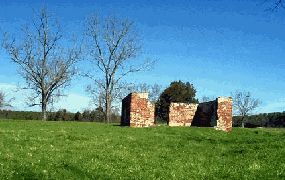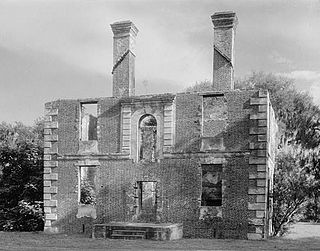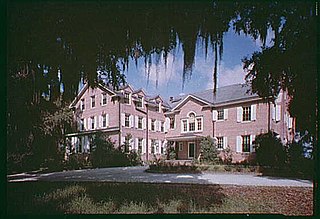
Kingstree is a city and the county seat of Williamsburg County, South Carolina, United States. The population was 3,328 at the 2010 census.

Westover Plantation is a historic colonial tidewater plantation located on the north bank of the James River in Charles City County, Virginia. Established in c. 1730–1750, it is the homestead of the Byrd family of Virginia. State Route 5, a scenic byway, runs east–west to the north of the plantation, connecting the independent cities of Richmond and Williamsburg.

Green Spring Plantation in James City County about five miles (8.0 km) west of Williamsburg, was the 17th century plantation of one of the more popular governors of Colonial Virginia in North America, Sir William Berkeley, and his wife, Frances Culpeper Berkeley.

Carter's Grove, also known as Carter's Grove Plantation, is a 750-acre (300 ha) plantation located on the north shore of the James River in the Grove Community of southeastern James City County in the Virginia Peninsula area of the Hampton Roads region of Virginia in the United States.

Rosewell Plantation in Gloucester County, Virginia, was for more than 100 years the home of a branch of the Page family, one of the First Families of Virginia. Begun in 1725, the Flemish bond brick Rosewell mansion overlooking the York River was one of the most elaborate homes in the American colonies.

Mount Airy, near Warsaw in Richmond County, Virginia, constructed in 1764 for Colonel John Tayloe II, perhaps the richest Virginia planter of his generation, is a mid-Georgian plantation house, the first built in the manner of a neo-Palladian villa. John Ariss is the attributed architect and builder. Tayloe's daughter, Rebecca and her husband Francis Lightfoot Lee, one of the only pair of brothers to sign the Declaration of Independence are buried on the estate, as are many other Tayloes. Before the American Civil War, Mount Airy was a prominent racing horse stud farm, as well as the headquarters of about 10-12 separate but interdependent forced-labor plantations along the Rappahannock River. Mount Airy is listed on the National Register of Historic Places as a National Historic Landmark as well as on the Virginia Landmarks Register and is still privately owned by Tayloe's descendants.

McLeod Plantation is a former slave plantation located on James Island, South Carolina, near the intersection of Folly and Maybank roads at Wappoo Creek, which flows into the Ashley River. The plantation is considered an important Gullah heritage site, preserved in recognition of its cultural and historical significance to African-American and European-American cultures.
This is a list of the National Register of Historic Places listings in Knox County, Tennessee.

Salters is a small unincorporated community in the southwest central portion of Williamsburg County, South Carolina, United States, in the state's Low Country region. The zip code is 29590 and the area code is 843. Charleston, South Carolina and Myrtle Beach, South Carolina are within driving distance of Salters making for an enjoyable day trip to either. Forestry is the main industry in Williamsburg County. Nearby towns include Kingstree, Greeleyville, and Lane. Salters is the location of Federal Corrections Institution, Williamsburg. The Salters Plantation House was listed on the National Register of Historic Places in 2000.

The Paul Hamilton House, commonly referred to as the Brick House Ruins, is the ruin of a 1725 plantation house on Edisto Island, South Carolina, that burned in 1929. It was designated a National Historic Landmark in 1970 for the unusual architecture of the surviving walls, which is partly based on French Huguenot architecture of the period.

Hampton Plantation, also known as Hampton Plantation House and Hampton Plantation State Historic Site, is a historic plantation, now a state historic site, north of McClellanville, South Carolina. The plantation was established in 1735, and its main house exhibits one of the earliest known examples in the United States of a temple front in domestic architecture. It is also one of the state's finest examples of a wood frame Georgian plantation house. It was declared a National Historic Landmark in 1970.

Middleburg Plantation is a historic colonial-era plantation on the Cooper River near Huger, South Carolina. The plantation house, built in 1697 by the French Huguenot Benjamin Simons, is probably the oldest standing wood-frame building in South Carolina, and is consequently an architecturally important example of period construction. It was declared a National Historic Landmark in 1970.

Broad Margin is the name given to the private residence originally commissioned by Gabrielle and Charlcey Austin. It is located in Greenville, South Carolina, United States, was designed by Frank Lloyd Wright and was built by local builder Harold T. Newton in 1954. It is one of two buildings designed by Wright in South Carolina.

Rose Hill Plantation House is an historic Carpenter Gothic house located on US 278 in Bluffton, Beaufort County, South Carolina. It was begun in 1858 for Dr. John Kirk and Caroline Kerk, his wife, but construction was interrupted by the Civil War and not resumed until after World War II when it was renovated and finished by architect Willis Irvin for John Sturgeon and Florence Sturgeon, his wife. On May 19, 1983, it was added to the National Register of Historic Places. It preserves the antebellum plantation home of Dr. & Mrs. John William (1803-1868) & Caroline (1815-1864) Kirk, a wealthy planter and physician.

Hobcaw Barony is a 16,000 acres (6,475 ha) tract on a peninsula called Waccamaw Neck between the Winyah Bay and the Atlantic Ocean in Georgetown County, South Carolina. Much of Hobcaw Barony is south of US Highway 17. The land was purchased by the investor, philanthropist, presidential advisor, and South Carolina native Bernard M. Baruch between 1905 and 1907 for a winter hunting retreat. Later, his eldest child, Belle W. Baruch, began purchasing the property from her father beginning in 1936. By 1956, Belle owned Hobcaw Barony entirely. Upon her death in 1964, the property was transferred to the Belle W. Baruch Foundation for a nature and research preserve. The property includes more than 37 historic buildings and structures representative of the eras of both 18th & 19th century rice cultivation and 20th century winter retreats. Hobcaw Barony was named to the National Register of Historic Places on November 2, 1994.

Medway or the Medway Plantation is a plantation in Mount Holly, South Carolina within Berkeley County, South Carolina. It is about 2 mi (3.2 km) east of U.S. Route 52 from the unincorporated community of Mount Holly, which is directly north of Goose Creek, South Carolina. It was named to the National Register of Historic Places on July 16, 1970.

Loch Dhu is a house in northwestern Berkeley County, South Carolina about 7 mi (11 km) east of Eutawville, South Carolina. It was built around 1812–1816. It is located close to Lake Marion about 1.3 miles (2.1 km) north of South Carolina Route 6 on Loch Dhu Lane. It was named to the National Register of Historic Places on July 13, 1977.

This is a list of the National Register of Historic Places listings in Williamsburg County, South Carolina.

Annandale Plantation, originally known as Millbrook, is a historic plantation house located near Georgetown, in Georgetown County, South Carolina.

Thorntree, also known as the Witherspoon House, is a historic plantation house located at Kingstree, Williamsburg County, South Carolina. It was built in 1749 by immigrant James Witherspoon (1700-1765), and is a two-story, five-bay, frame "I-house" dwelling with a hall and parlor plan and exterior end chimneys. It features full-length piazzas on the front and rear elevations. To preserve it, the house was moved from an inaccessible rural site to Kingstree on land donated as a memorial park, known as Fluitt-Nelson Memorial Park. The house has been restored to its 18th-century appearance and is open to the public by appointment with the Williamsburg Historical Society.






















